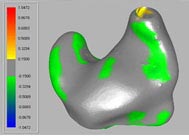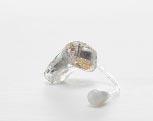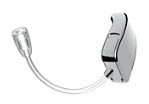Interview with Brian Tsuchiya, VP of Custom Business, ReSound
Share:
Topic: Custom Product Innovations by ReSound
 CAROLYN SMAKA: Brian, welcome to AudiologyOnline!
CAROLYN SMAKA: Brian, welcome to AudiologyOnline!BRIAN TSUCHIYA: Thank you so much Carolyn, and I appreciate the time you're taking today to have this conversation.
SMAKA: Hey, that's my line! [laughs]. Thank you for your time today as well. Brian, can you tell me about your background and what you do at ReSound?
TSUCHIYA: Sure. I've been with ReSound now for about five years, and I'm currently responsible for our custom business.
What that means is I'm responsible for manufacturing operations as well as establishing commercial strategies with our team. My team also works closely with our customers to ensure that we are delivering what they're asking for. A large part of what we do involves obtaining insight and input from our customers on product features and capabilities, in order to continue to satisfy their custom hearing instrument product needs.
It's a big challenge, but we have a very talented group working in this capacity and I enjoy my work very much.
Previous to ReSound, I worked in other industries, primarily from an operations perspective. And it may sound a bit unique, but just prior to joining ReSound, I ran operations for an airline here in Minneapolis.
SMAKA: Really? What an interesting background.
TSUCHIYA: It may at first sound like a very strange transition from the airline industry to the hearing industry. Actually, though, when you consider how closely the airline industry is aligned to its customers, you will see that it is a very good background to have. In the airline industry, you must effectively understand customers' needs and be able to respond quickly to create solutions. You must also empower your front line employees to make principle-based decisions quickly. So it has actually been a very smooth transition for me.
In the hearing industry, we certainly need people that have been in the industry for years and are industry experts, but it is also an advantage to bring in some fresh perspectives. Being from outside the industry, you can share things that work well or don't work well in other industries, and challenge them to see if they will work in the hearing industry.
One of the things I learned in my years prior to ReSound is the value proposition consists of more than the specific product. In ReSound's custom business we are selling more than the product. We're selling innovation. We're selling flexibility. We're selling solutions.
So at ReSound, we like to think in terms of providing personalized solutions. Personalized solutions not only for our customers, but also for their patients. Thinking of custom hearing instrument manufacturing in those terms gives us focus as we touch these products every day.
SMAKA: A few months back I had the pleasure of speaking with Vince Maye, Director of Custom Business Development, about ReSound's TRUFIT process. Is TRUFIT an area of your responsibility?

All ReSound custom products are made with the proprietary TRUFIT™ process
TSUCHIYA: Yes. We formally launched TRUFIT approximately one and a half years ago, although it has been in development for quite some time. As we continue to work closely with our customer base, TRUFIT is becoming more and more of a primary topic.
As you know, ReSound's TRUFIT process was the result of Vince Maye and other engineers investing hundreds of hours investigating all of the variables in the entire value stream of a custom hearing instrument. Those variables include things like impression taking techniques, impression materials, and other variables in the manufacturing process. We set out to control the process variables from the point the customer takes an ear impression all the way through to the point that the customer fits the patient with our custom hearing instrument.
The result of these investigations - literally hundreds of hours of research and development - is our TRUFIT system that helps control all of the variables in the entire custom hearing instrument process.
During our investigations we worked very closely with our customers to understand their preferred impression material and techniques.
SMAKA: How does TRUFIT control that variability?
TSUCHIYA: In a multitude of ways - I'll give you an example. TRUFIT's shell fabrication process has at its foundation a similar technology as SLA or DLP that other manufacturers are using. However, the technology and processes typical to the industry involves having to buff, tumble or lacquer the shells, which can introduce variability and potential inaccuracy or fit problems in the finished instruments. Our TRUFIT system, also known as a buffless process, as we have been able to add some unique differences to our system to avoid secondary processes on our shells. We're therefore able to tightly control the integrity of the patient's impression, as well as the design of the shell. That's an important component of TRUFIT. It is also relevant to note that 100% of our shells are subject to our TRUFIT digitized process.
An additional component of TRUFIT is what we call our E-design group. E-designers review every order, design the shell for best fit and comfort, and also use a patient optimizer to select the appropriate canal length and vent size. This has proven itself in very, very good fit rates, and most importantly, by wide acceptance by our customer base.
We also have a key group called TRUFIT Technical Support, TFTS for short, which speaks to customers about their orders and evaluates their orders with regularity to ensure a smooth process.
SMAKA: What about challenging fittings like patients with severe TMJ?
TSUCHIYA: I'm glad you brought that up, Carolyn. We have some unique software features that enable our technicians to evaluate and assess the amount of movement and change in the geometry of the ear canal to ensure that we design our shells to accommodate those types of patients. This evaluation requires both an open and closed jaw impression. TRUFIT enables us to design a shell for fit, comfort, as well as for a good acoustic seal, with a high degree of accuracy. The real proof of this is in the acceptance by our customers and their patients.
TRUFIT is a unique system, and a real differentiator for ReSound.
SMAKA: Like all innovations, I'm sure TRUFIT continues to develop?
TSUCHIYA: That's exactly right, Carolyn. In fact, over the last several weeks we had an open house and had several dozens of customers in our facility to learn about be by ReSound Custom. It was great to hear their positive feedback about TRUFIT and very eye opening to get their opinions and insights about a variety of topics.

be by ReSound Custom
SMAKA: Can you talk about be by ReSound Custom from a manufacturing perspective?
TSUCHIYA: It is an exciting and innovative new product. One thing we're very proud of is that the development of be by ReSound Custom occurred right here in our Bloomington facility, in our engineering group. And it really is a result of three things - customer input, the original be by ReSound, and our TRUFIT system.
be by ReSound has tremendous advantages, and is certainly innovative. We consider be by ReSound Custom to be "the evolution of a revolution", with be by ReSound as the evolutionary product.
be by Resound Custom was developed through hours and hours of talking to customers directly, getting their feedback, listening to their recommendations, and analyzing the benefits of the design of be by ReSound.

be by ReSound
Our engineering group and our custom team did several things in order to take advantage of that design. We've taken steps in our shell design to accommodate the advantages of the remote microphone. And we've taken a closer look at the material composition used for be by ReSound Custom.
When we roll all that together, the result is a very small and aesthetically pleasing device.
The other benefit, due to the efforts of shell design and material composition, is noticeable improvement in the sound fidelity, which one would think would be pretty difficult to do considering that ReSound has always been known for great sound processing.
But because of our efforts, we've actually been able to improve even further in this area. A noticeable improvement in sound fidelity has been a primary observation from consumers. We're obviously very happy with that outcome.
be by ReSound Custom may be the most personalized hearing instrument in the industry today, and as I mentioned before, we're in business to provide personalized solutions.

be by ReSound Custom virtually disappears on the ear
SMAKA: One thing I'm hearing you say constantly throughout this interview is how involved your customers are in your processes.
TSUCHIYA: Yes, exactly. Through various outreach activities, we speak with customers about our TRUFIT system, and what we can do to improve our products, our manufacturing processes, and the results that they receive from us. It's an absolute necessity. In the airline industry, customer feedback is immediate. Whether it's positive feedback or negative feedback, it happens immediately and it drives a lot of change. For us at ReSound, it is no different, especially with our custom products.
Since everything we do is customized and personalized, as long as we have an open ear to our customers and an operation that's very nimble, we can respond quickly to customers' needs.
And at the end of the day, as much experience as we may collectively have on the manufacturing side, it's our customers' experience that's most important.
SMAKA: Brian, we know that since the advent of open canal products worn behind the ear, custom products are more or less 40 to 50 percent of the overall market. What do you foresee for the future of custom business?
TSUCHIYA: That's a great question, Carolyn. We've always felt very confident that, in general, many consumers still prefer an in-the-ear instrument and that's what we hear from our customers as well. And we're seeing that reflected in our business. Despite the trend toward BTEs in the overall U.S. hearing instrument custom market, and despite the obvious current economic conditions, ReSound is actually showing substantial growth in our custom business, largely on the heels of be by ReSound Custom.
We believe this is also due to our TRUFIT system, as well as to our absolute commitment to providing personalized solutions to our customers. We are certainly pleased with the growth that we are seeing.
We have continued to work tirelessly to innovate with our custom instruments because we see a continued market demand for them for the long term. For example, the kind of innovation found in be by ReSound Custom hasn't been seen in the industry for quite some time.
As we've worked closely with our customers and closely with their patients, we've realized that the design that we have with be by ReSound Custom enables us to produce more power in a smaller package. This design has also allowed us to overcome some of the traditional disadvantages of custom instruments of the past, so we expect to see an upward trend in the custom hearing instrument market with this product.
One example of this is wind noise - both BTEs and some custom products are subject to wind noise or the noise of hair scratching over the microphone. I often run into patients that are bothered by these noises. With be by ReSound Custom, the microphone is positioned such that the helix provides the maximum amount of protection against wind noise. Another common limitation of other instruments is feedback. With be by ReSound Custom, we are able to neutralize feedback in the great majority of the situations we've encountered.
We believe be by ReSound Custom can become a catalyst to start reinvigorating the custom market because of all of its unique benefits.
SMAKA: I just heard that ReSound is also making earmolds. Is that correct?
TSUCHIYA: Yes, that is correct. We have taken our TRUFIT system as it applies to our custom manufacturing, and directly applied it to the manufacture of custom earmolds.
It is the same process that we use for custom instruments, so we have very accurate custom earmolds with the same level of quality as our custom products.
Since we are using the same proven TRUFIT system and we offer the convenience of one-stop shopping for BTEs and earmolds, we expect our earmold business will continue to grow. Our objective here is to be a growth partner with our customer. Part of that opportunity is to make things easier for them and their practices, and earmold manufacturing is one example of how we can do that.

ReSound offers earmolds made from the same proven TRUFIT process used with custom instruments
SMAKA: What's the latest news on scanning ear impressions in customers' offices?
TSUCHIYA: We actually have placed scanners in some customers' offices because they are in a remote location, for example. We specify a specific scanner for the following reason.
In our TRUFIT system, our in-house scanning process is a high-resolution digital scanner that maintains a high integrity of capturing the physical impression of the patient.
If our customers use a scanner that does not have the same resolution, it may introduce variables in the process (and resulting inaccuracies) that we have worked very hard to remove.
So if customers do want to use scanners, we will work with them very closely, and help them specify which scanner to use.
SMAKA: Would a direct ear scanner further help to reduce variability in custom manufacturing, if it ever really comes to replace ear impression taking as we know it today?
TSUCHIYA: Well, as long as it captures the complete and accurate anatomy of the patient's ear. We would need to be assured that it would maintain the integrity of the ear-to-ear process. Because again, what is most important in the world of custom products is fit and comfort. We would certainly lend our support to any future technological developments that can help assure us of that.
SMAKA: You know, I never thought about it until this minute, but you are right. As there is variability in impression-taking techniques, there is nothing to say that there could not be variability in ear-scanning techniques. I had always just thought, oh, wouldn't that be nice, to not have to take ear impressions someday.
TSUCHIYA: Yes, it certainly would be convenient. But at the end of the day, what you really care about are the results that you are delivering to your patient.
SMAKA: Yes, exactly. Brian, it's been great hearing about ReSound's custom business, thank you again for your time.
TSUCHIYA: Carolyn, it's been my pleasure and I hope we get to do it again in the future.
SMAKA: You bet!
About ReSound
ReSound develops technology and solutions to improve quality of life for hearing impaired throughout the world. Founded in 1999 through a merger of GN Danavox and ReSound Corporation combining 90 years of hearing instrument development, ReSound today upholds its illustrious history as a leading manufacturer of cutting-edge hearing instruments in major global markets. ReSound North America is headquartered in Bloomington, MN. For more information, visit www.gnresound.com, or the ReSound Web channel on AudiologyOnline.


